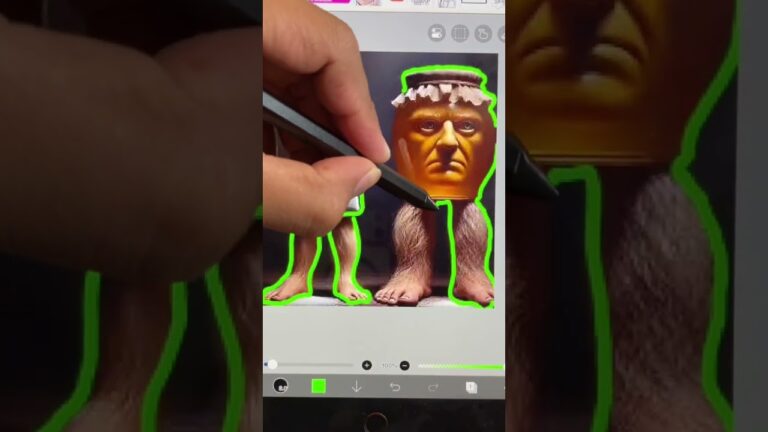[ad_1]
Okay, here’s a breakdown of how you might approach drawing Garamaram (assuming you’re referring to the character from "Delicious in Dungeon," also known as "Dungeon Meshi"):
I. Understanding Garamaram’s Design
-
Reference Images: The most critical step is to gather good reference images. Look for official artwork, manga panels, anime screenshots, and fan art. Pay attention to:
- Proportions: How tall is he? How long are his limbs relative to his torso?
- Facial Features: The shape of his eyes, nose, mouth, and ears. Note the details like the shape of his pupils, any wrinkles, and the set of his eyebrows.
- Clothing: Details of his armor, robes, and any accessories. Notice how the fabric drapes and folds.
- Color Palette: Note the colors used for his skin, hair, clothing, and armor.
- Pose: Study how he stands, moves, and holds weapons.
- Key Characteristics: Identify the features that make Garamaram instantly recognizable. For example:
- His dwarven stature.
- His traditional dwarven beard and hairstyle (often elaborately braided or styled).
- His serious, sometimes grumpy, expression.
- His practical adventuring attire (likely a mix of armor and functional clothing).
- The tools he often uses (e.g., hammers, picks).
II. Basic Construction
-
Gesture Drawing: Begin with a loose, dynamic gesture drawing to capture the overall pose and flow of the figure. Focus on the action line (the line of movement through the body) and the rhythm of the pose. Don’t worry about details at this stage. Keep it very light and sketchy.
-
Simplified Forms: Break down the body into basic geometric shapes (circles, ovals, cylinders, boxes).
- Head: Use a circle or oval for the skull.
- Torso: Use a box or modified oval for the ribcage.
- Pelvis: Use a smaller box or oval.
- Limbs: Use cylinders for the arms and legs.
- Hands and Feet: Use simple blocks or wedges.
-
Proportions and Placement: Use your reference images to accurately position and size the shapes relative to each other.
- Dwarves are shorter and stockier than humans. Pay close attention to limb length and overall body height.
- Mark the placement of joints (shoulders, elbows, wrists, hips, knees, ankles).
- Connect the Shapes: Use smooth, flowing lines to connect the geometric shapes and create the basic outline of the body. Refine the contours and adjust the proportions as needed.
III. Adding Details
-
Facial Features:
- Guidelines: Draw vertical and horizontal guidelines on the face to help position the eyes, nose, and mouth.
- Eyes: Shape of the eyes; placement of the pupils and irises. Don’t forget the eyebrows, which play a large role in expressing emotion.
- Nose: The shape and size of the nose. Pay attention to the bridge, the tip, and the nostrils.
- Mouth: The shape of the lips and the expression of the mouth.
- Beard and Hair: Sketch the overall shape of the beard and hairstyle. Add details such as braids, knots, and individual strands of hair. Dwarven beards are often very detailed.
- Ears: Draw the ears, paying attention to their placement on the head and their internal structure.
-
Clothing and Armor:
- Layering: Sketch the different layers of clothing. Start with the garments closest to the body and work outward.
- Folds and Wrinkles: Observe how the fabric folds and wrinkles in your reference images. Use curved lines to indicate the folds and shadows to add depth.
- Armor Details: Carefully draw the details of the armor, such as plates, rivets, and buckles. Pay attention to the thickness and shape of each piece.
-
Hands and Feet:
- Simplified Shapes: Break down the hands and feet into simple shapes, such as boxes and cylinders.
- Fingers and Toes: Draw the fingers and toes, paying attention to their length and curvature.
- Joints and Creases: Add details such as knuckles, wrinkles, and creases.
- Accessories: Add any additional accessories, such as weapons, tools, pouches, or jewelry.
IV. Line Art
- Refine the Sketch: Clean up your sketch by erasing any unnecessary lines and refining the details.
- Line Weight: Use varying line weights to create depth and emphasis. Thicker lines can be used for outlines and areas in shadow, while thinner lines can be used for details and highlights.
- Clean Lines: Carefully draw over your sketch with clean, confident lines. You can use a pen, pencil, or digital drawing tool.
V. Shading and Coloring (Optional)
- Light Source: Determine the direction of the light source.
- Shadows: Add shadows to the areas that are not directly illuminated by the light source. Use darker shades for areas in deeper shadow and lighter shades for areas in partial shadow.
- Highlights: Add highlights to the areas that are directly illuminated by the light source.
- Coloring: Choose your colors based on your reference images. Use different shades and tones to create depth and realism.
- Blending: Blend the colors and shades together to create a smooth transition between them.
VI. Tips and Techniques
- Practice Regularly: The more you practice, the better you will become at drawing.
- Use References: Always use reference images to help you draw accurately.
- Study Anatomy: Understanding human and dwarven anatomy can help you draw more realistic figures.
- Experiment with Different Styles: Don’t be afraid to experiment with different drawing styles and techniques.
- Use Layers (Digital Art): Working in layers in digital art programs allows for easy correction and adjustment of individual elements.
- Break Down Complex Shapes: Always simplify complex shapes into basic geometric forms before adding details. This helps maintain proportions and makes the drawing process more manageable.
- Focus on the Fundamentals: Practice basic drawing skills such as line control, shading, and perspective.
- Observe Real Life: Study the world around you and pay attention to how light and shadow work, how fabric drapes, and how different materials look.
Remember to adapt this process to your preferred art style and medium. Good luck!
[ad_2]

